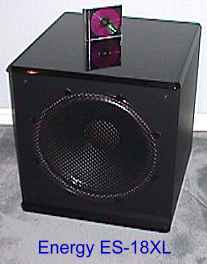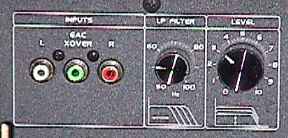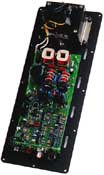John E. Johnson, Jr.

|
Energy ES-18XL Subwoofer 18" Driver 400 watt rms Amplifier |
| Audio Products International Corporation, 3641 McNicoll Avenue, Scarborough, Ontario, Canada M1X 1G5; Telephone 416-321-1800; Fax: 416-321-1500; E-Mail: [email protected]; Web: http://www.energy-speakers.com. |
As many of you know, Energy Loudspeakers is a line that looks very much like Mirage Loudspeakers. That is because it is the same company, but a more modestly priced array of models. We tested the Mirage BPSS-210 Subwoofer some time ago, and feel it is the "King of Clean". Even at full output, there was no audible sound when the signal was an 18 Hz sinewave. Small drivers (bipolar 10") coupled with servo-feedback result in inaudible harmonics. The Energy ES-18XL is a different animal entirely. The amplifier and crossover network are built-in (the BPSS-210 requires an external crossover, and we use the Mirage LFX-3). The ES-18XL has an 18" driver, and a very large, very heavy (150 pounds) enclosure. In fact, this is the heaviest subwoofer we have yet tested. The top of the enclosure is gloss black like Mirage subwoofers. The ES-18XL is not servo-feedback.

Although the Energy has a conventional-looking
grille cloth on the front, there is also a metal grille that covers
the driver. As a result, it has a very interesting appearance
with the grille removed and can be left that way if you want.
The rear of the enclosure  has the
amplifier controls, consisting of rotary volume and low-pass crossover
frequency, continuously adjustable from 50 Hz - 100 Hz (24 dB/octave).
There are three line-level RCA input jacks, one each for the the
left and right channels, which go through the low-pass crossover,
and one that bypasses the crossover, needing an external crossover
such as the LFX-3 or THX controller. There is no on/off switch,
in keeping with that trend. The reason for this, besides eliminating
the effects of turn-on surge, is that the power amplifier (400
watts rms) is digital Pulse Width Modulation (PWM) in nature.
This allows for very high efficiency, and the amplifier never
gets very warm. So, at idle, it is not burning much electricity.
If you like to turn things off after using them, you can connect
the subwoofer to a switchable AC line conditioner. An automatic
signal sensing circuit turns the main power off anyway, after
some time at idle, but of course power is there, running the signal
sensors. There is also a clipping protection circuit.
has the
amplifier controls, consisting of rotary volume and low-pass crossover
frequency, continuously adjustable from 50 Hz - 100 Hz (24 dB/octave).
There are three line-level RCA input jacks, one each for the the
left and right channels, which go through the low-pass crossover,
and one that bypasses the crossover, needing an external crossover
such as the LFX-3 or THX controller. There is no on/off switch,
in keeping with that trend. The reason for this, besides eliminating
the effects of turn-on surge, is that the power amplifier (400
watts rms) is digital Pulse Width Modulation (PWM) in nature.
This allows for very high efficiency, and the amplifier never
gets very warm. So, at idle, it is not burning much electricity.
If you like to turn things off after using them, you can connect
the subwoofer to a switchable AC line conditioner. An automatic
signal sensing circuit turns the main power off anyway, after
some time at idle, but of course power is there, running the signal
sensors. There is also a clipping protection circuit.
We tested the ES-18XL in our audio lab and in our home theater lab, using a variety of equipment (see reference components page).
Because there is no phase adjustment control, placement of the Energy subwoofer has to be done a little more carefully than some other speakers that have this control. However phase adjustment controls only correct the phase at one frequency, so it is not a terrible ordeal as long as you pay attention to what you are doing.
We placed the Energy 1 foot out from the wall, near but not in a corner. A CD that I like very much for use with subwoofers is "The Great Fantasy Adventure Album". It has tremendous bass lines that test any subwoofer. The opening cut is from "El Cid", and there are several places where there are very low notes. Although the ES-18XL did not play them as cleanly as the BPSS-210, the Mirage subwoofer will not play them as loud, mostly because there is nothing like an 18" driver to move lots of air. In fact, when I stood near the ES-18XL, I could feel the wind blowing against my legs.
In our home theater, the Energy took to the task beautifully. Of course, that is what this subwoofer is designed for. It is not a white wine and candlelight component. This thing is built for "Starship Troopers" and other such fare. No fluff here. When it cranks, get out of the way. It doesn't have the house moving power of some of the 1200 watt jobs, but it grades the road nevertheless. With sinewaves, I can usually get an amplifier to become quite warm. But not the Energy. I really like the digital amplifiers for use with subwoofers.
| Room Response - Energy ES-18XL Subwoofer -- Grille off -- Set to 90 dB at 20 Hz -- (This is not maximum output, but rather just the response in an "average" room with the volume set to 90 dB at 20 Hz.) |
| 1 meter | 13 feet |
| 10 Hz | 69.0 dB | 10 Hz | 77.1 dB |
| 12.5 Hz | 80.6 dB | 12.5 Hz | 83.9 dB |
| 16 Hz | 83.4 dB | 16 Hz | 80.0 dB |
| 20 Hz | 90.6 dB | 20 Hz | 90.4 dB |
| 25 Hz | 90.2 dB | 25 Hz | 87.7 dB |
| 31.5 Hz | 95.4 dB | 31.5 Hz | 93.6 dB |
| 40 Hz | 86.5 dB | 40 Hz | 88.4 dB |
| 50 Hz | 87.3 dB | 50 Hz | 87.9 dB |
| 63 Hz | 93.0 dB | 63 Hz | 91.0 dB |
| 80 Hz | 97.3 dB | 80 Hz | 95.1 dB |
| 100 Hz | 94.0 dB | 100 Hz | 93.0 dB |
| 125 Hz | 91.8 dB | 125 Hz | 88.0 dB |
| 160 Hz | 84.4 dB | 160 Hz | 82.0 dB |
As you can see, usable response goes to below 20 Hz. Unless you are playing pipe organ music all the time, 20 Hz is sufficient. I heard some harmonics with the 12.5 Hz and 16 Hz sinewaves, but only with the volume turned up to a very high level. It actually had very nice performance characteristics for no servo-feedback. At 31.5 Hz, I could obtain a volume that made me dizzy (the vestibular canals of the inner ear are chambers filled with fluid that can be set to vibrating), without overloading the speaker, so I figure this product has plenty of muscle where it counts. There was no boominess to the speaker, and I suspect this was due to the massiveness of the enclosure.
In summary, Energy adds a formidable contender to its line of products with the ES-18XL. Unique to this particular model are the metal grille covering the driver, an incredibly sturdy enclosure, and a digital amplifier. If you like subwoofers, you will certainly be impressed with this one.
John E. Johnson, Jr.
© Copyright 1998 Secrets of Home Theater & High Fidelity
Return to Table of Contents for this Issue.

